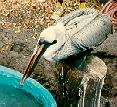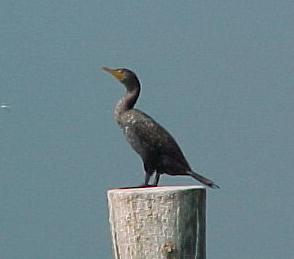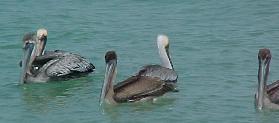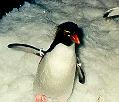MARINE BIRDS
Marine birds living at the seashore or far out to sea have become secondarily adapted to the ocean. They possess webbed feet and salt glands that empty into their nose, excrete nitrogenous wastes as insoluble uric acid to conserve water, feed on fish, squid garbage carrion etc. and must return to shore to nest. They are plentiful where food is abundant (upwellings, salt marshes etc.) Competition is reduced between species because of specific adaptations enabling them to
- 1.feed on different foods
- 2. nest in different places and
- 3.remain active at different times of the day.
1. Stilt-legged birds Long legs help bird search shallows for food. Herons and egrets wade salt marsh waters, where sand pipers are found along the beaches. The length of the neck, beak, and legs determines where and what types of food are available. examples: heron and egret ...strike at small fish and insects, grasping it into their beaks and swallow their catch head first (won't lodge in throat. Others/probe in sand or mud to search for worms/insects ...flamingos lower their heads upside down scooping a mouthful of food and water into their hooked beaks and use their tongue as a plunger, pushing the water out straining the food.
2. Terns and skimmers (Sterna hirundo and Rynchops nigra) Long-pointed wings and a forked tail enabling them to hover over the water using keen eyes with polarizing filters to see small fish swimming in the water. The black skimmer flies close to the waters surface and places its oversize lower bill 2 inches into the water and when their bills touch a small fish, ( their eyes are positioned so they can't see the water...touch is needed) their tails and wings drop to slow them down...the impact is enough to cause the skimmers head to bend backward and at this point the fish is swallowed whole. Their eyes are the only gulls that possess a vertical pupil (like a cat) which enable them to fly at twilight and dark when other birds can't. The elongated mandible of the beak makes it impossible for adult skimmers to feed while standing near the shore (young skimmers possess a more traditional beak while developing).
3. Gulls ( Larus sp.)There are 43 species of gulls and their survival depends on their lack of specialization...they feed on anything along the shore, serving as useful scavengers. They are currently endangering tern populations by competing with them by building their nests in sandy dune area formerly occupied by the terns. They forage for their food in water and land, and often pick up clams fly up about 40' and drop them onto the street breaking them open and then rushing to eat it.
4. Cormorants (Phalacrocorax)
Usually seen swimming low over the water searching for
schools of fish...when located, they settle into the water
and make repeated surface dives, using their webbed feet to
swim underwater. Its long neck and pointed beak help it probe
among blades of sea grass and rock crevasses as it chases
small fish. It consumes hundreds of small fish per day
because of its high metabolic rate and are used by Asians to
catch fish...a ring is placed around the long neck to prevent
the bird from swallowing the fish and are trained to dive
from fishing boats into a school of fish. They are fed fish
small enough to fit past the neck ring and become dependent
on their captors. They are often tethered on lines used to
pull them back into the boats. the fish are then expelled
from the esophagus and crop by gentle prodding. (crop stores
food the birds gulp down rapidly)
5. Brown Pelicans (Pelecanus
occidentalis) A big bird with a large pouch below its
bill which it uses to catch fish. They live in large colonies
and when fish are located, they plunge into the water with
their bills open, bob to the surface with the pouch filled
with a gallon of sea water and fish. By pushing their heads
against their necks, the bird expels the seawater through
grooves on their bills.

6. Frigate Birds (Fregatta) Found throughout the tropics and capable of flying far out to sea, and beautiful soaring flight that can out maneuver almost any bird but it cannot settle on the water. they never swim, float or enter the water and must return to shore at the end of the day to rest. They dive toward the water plucking flying fish out of the air, and grabbing small fish and squid from the surface while only wetting the tips of their beaks. They also harass other birds into vomiting their catch and feed on this.
7. Pelagic Birds Many seabirds spend almost their entire life beyond sight of the shore and these are pelagic birds. (return only to breed). Included are Puffins and albatrosses, sooty shearwaters (migrate 20,000 miles) and storm petrels and gannets.
8. Penguins 

Adaptations
- 1. Buoyancy Birds contain fatty deposits and thin light bones, possess oil glands near their tails (water proofs feathers) (preen) and presence of many air sacs in the thorax, abdomen and long bones of their legs and wings
- 2. Heat Loss Body temp. between 106°F-103°F using air trapped under the feathers to insulate their bodies. Penguins also have blubber under their skin keeping them warm in -80°F .
- 3. Diving By exhaling air from their air sacs and lungs, squeezing air from under their feathers, they can reduce their ability to float to dive under the surface. Their heart rate slows when they dive.
- 4. Migration seasonal migration between feeding and nesting grounds occurs with breeding usually occurring near the poles and feeding in the mid-latitudes. Young birds inherit detailed genetic instructions that allow them to migrate thousands of miles across the water. The longest, the arctic tern (Sterna paradisaea) nests in the arctic in the summer and flies south for the winter to within sight of the Antarctic ice (20,000 miles).
- 5. Senses Sight...excellent binocular vision to perceive fish swimming in deep water. A nictitating membrane, third eyelid protects eyes when diving. Hearing and smell don't appear to be vital in marine birds, although birds hear higher frequency than humans. Taste is the least underdeveloped sense, and birds have no teeth and few taste buds, swallowing food quickly without chewing or tasting it.
Ecological importance
Vital components of marine food web, feeding on and adding to the water droppings to fertilize surface water to stimulate growth of marine plants. Birds are attracted to certain areas and leave guano. Industry.
NAME FOOT&/OR GROUP FEEDING UNUSUAL CHARACTERISTIC
- Heron Stilt-legged Swallow fish head first yellow legs/black bill
- Egret Stilt-legged Swallow fish head first black legs/yellow bill
- Flamingo Stilt-legged Strain water for fish pink/long legs
- Ibis Stilt-legged swallow fish head first long downward curved diving or wading bill
- Roseate Stilt-legged diving or wading small, pink flying bird spoonbill flat bill
- Pelican Webbed-feet scoops up water & fish poor diver/large bill pouch, nests in mangroves
- Cormorant Webbed-feet Dives, swims underwater hooked bill, trained to fish by man
- Anhinga Webbed-feet Swims underwater spears straight bill, no preen fish gland, must dry feathers often called snakebird
- Frigate Flying stealing catch never enter water, redthroat/outmaneuver anyother marine birds- Y shaped tail.
- Gulls Flying land or water scavengers most common marine bird shore and coastal animals nest in dunes
- Penguins Pelagic fish, krill, squid are Antarctica, no flight swallowed underwater
- Puffin Pelagic fish, krill, squid are seldom on land/wide,
- Osprey Vulture Family dives, carries fish back builds huge nest near to nest to shred & devour water, top carnivore